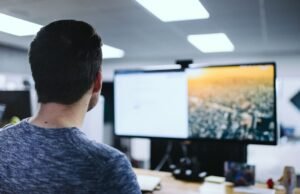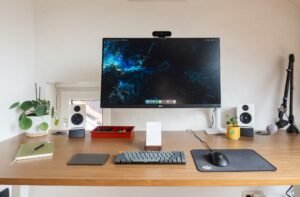How AI Art Is Created
Artificial Intelligence (AI) has made significant advancements in various fields, one of which is art. With the ability to analyze vast amounts of data and generate new ideas, AI has revolutionized the art creation process. This article explores the fascinating world of AI art and how it is crafted.
Key Takeaways:
- AI art is created using sophisticated algorithms and deep learning techniques.
- AI-generated art can imitate various artistic styles or create entirely new ones.
- Artists collaborate with AI systems to produce unique and innovative artworks.
- AI art challenges traditional notions of creativity and raises ethical questions.
Artificial Intelligence (AI) systems are now capable of producing creative works, blurring the line between human and machine. AI art is created through the use of complex algorithms and deep learning techniques. These algorithms analyze enormous amounts of data to identify patterns and generate novel ideas. *AI-powered algorithms can adapt and improve based on their previous experiences, enabling them to create art that evolves over time.* This ability to learn and adapt gives AI artists a unique advantage in producing highly intricate and sophisticated artworks.
AI artists can imitate different artistic styles or create completely new ones. By training the AI algorithms on vast collections of artwork, they can recreate the style of famous painters, such as Van Gogh or Picasso. Additionally, AI systems can produce original artwork by combining elements from various styles and generating new compositions. *The versatility of AI enables artists to explore new creative possibilities that were previously unimaginable.*
Collaboration Between Artists and AI
The creation of AI art often involves collaboration between human artists and AI systems. The artist provides guidance and input to the AI, shaping the artistic direction and aesthetic choices. The AI, in turn, generates options and suggestions that the artist can explore further. This collaboration allows artists to leverage the computational power of AI to enhance their creative process. *It brings together the unique strengths of human imagination and machine capabilities, leading to exciting and unexpected outcomes.*
| AI Art Benefits | AI Art Challenges |
|---|---|
|
|
The rise of AI art challenges traditional notions of creativity and raises ethical questions. While AI can create stunning artworks, it is important to consider the implications of this technology on the art world. Ownership and copyright issues surrounding AI-generated art are still being debated. Moreover, the role of the artist in the creative process becomes blurred when working with AI. *However, AI art also opens up new possibilities for collaboration, experimentation, and innovation, expanding the horizons of the art world.*
A Glimpse into the Future
The world of AI art is constantly evolving, and its potential is yet to be fully explored. As AI systems continue to advance, we can expect even more sophisticated and awe-inspiring artworks to emerge. *The future of AI art holds endless possibilities, with AI artists pushing boundaries, challenging conventions, and reshaping the way we perceive and create art.*
| AI Art Advantages | AI Art Disadvantages |
|---|---|
|
|
Overall, AI art represents a fascinating intersection of technology and creativity. As AI systems continue to advance, the possibilities for artistic innovation are boundless. *Artists and AI collaborators are reshaping the art world, inviting us to question traditional norms and explore new frontiers.* Embracing the potential of AI art can lead to a dynamic and ever-evolving art landscape.

Common Misconceptions
1. AI-generated art lacks creativity
One common misconception about AI art is that it lacks creativity. Some people believe that since AI is essentially a machine programmed by humans, it cannot produce anything truly original or imaginative. However, this is not entirely true.
- AI algorithms can combine different artistic styles and create unique compositions.
- AI can explore vast datasets and come up with novel artistic concepts.
- AI-generated art can inspire human artists by pushing the boundaries of what is considered creative.
2. AI art eliminates the need for human artists
Another misconception is that AI art will replace human artists entirely. While AI can indeed create impressive pieces of art, it does not mean that human artists become obsolete.
- Human artists bring emotional depth and subjective interpretation to their work, something AI lacks.
- Collaboration between AI and human artists can lead to innovative and groundbreaking art forms.
- The artistic process involves more than just the final result, it is also about the personal journey and expression of the artist.
3. AI art is devoid of meaning and emotion
It is often assumed that AI-generated art lacks the ability to convey deep emotions or carry significant meaning. However, this is an oversimplification of how AI art is created and perceived.
- AI algorithms can be trained to understand human emotions and generate art that evokes a certain mood or feeling.
- AI-generated art can prompt meaningful discussions about the role of machines in creative expression.
- The interpretation and emotional connection to art can vary among individuals, regardless of its source.
4. AI art is solely a product of technical skills
There is a misconception that AI art is solely dependent on technical skills and lacks the artistic intuition that human artists possess.
- Creativity is a fundamental aspect of AI art, which goes beyond technical abilities.
- AI algorithms learn through training on vast amounts of artistic data, which allows them to develop an intuition for aesthetics.
- Human artists often utilize AI tools as a medium to enhance their own creativity and artistic vision.
5. AI art is only for the tech-savvy
Lastly, many people believe that AI art is only accessible and understandable to those with technical knowledge or expertise in the field of artificial intelligence. However, this is far from the truth.
- AI art can be appreciated by anyone with an interest in art, regardless of their technical background.
- Understanding the technical aspects behind AI art can enhance appreciation, but it is not necessary to enjoy or engage with the artwork.
- The democratization of AI tools has made it easier for individuals without technical skills to create their own AI-generated art.

The Evolution of AI Art
Over the years, artificial intelligence (AI) has made remarkable strides in various fields, including the realm of art. AI algorithms have been employed to generate astonishing artworks, blurring the line between human creativity and machine intelligence. The following tables highlight some fascinating aspects of AI art and shed light on the process of creating remarkable AI-generated masterpieces.
Artistic Styles Used in AI Art
One of the captivating aspects of AI art is its ability to mimic various artistic styles. Through deep learning techniques, AI algorithms can replicate the characteristics of renowned artists and produce remarkable artwork that resembles their unique styles. The table below showcases some of the popular artistic styles used in AI art:
| Artistic Style | Description |
|——————-|———————————————————————–|
| Impressionism | Known for capturing light and movement, with visible brushstrokes |
| Cubism | Emphasizes multiple viewpoints and abstract geometric forms |
| Surrealism | Portrays dreams, unconscious thoughts with unusual juxtapositions |
| Pointillism | Utilizes small dots of color to create a coherent image |
| Pop Art | Incorporates popular culture and mass media elements in artwork |
AI Art Collaborations
The integration of AI algorithms in art creation has led to fascinating collaborations between humans and machines. Artists have embraced AI tools as creative partners, blending their own artistic vision with the computational capabilities of AI. The table below presents some notable collaborations in AI art:
| Collaborators | Description |
|—————————|———————————————————————-|
| Mario Klingemann & Google | Creation of “Memories of Passersby I,” an AI-generated artwork |
| Refik Anadol & Nvidia | Collaboration resulting in mesmerizing AI-generated audiovisual art |
| Claire Maldives & Magenta| AI music composition in collaboration with an artist |
| Helena Sarin & DeepArt | Combining human painting and AI style transfer to create unique art |
| Robbie Barrat & Art Review| AI-generated artwork exhibited at the Art Review’s “Future 50” show |
AI Art in Auctions
The emergence of AI-generated art has made a significant impact on the art market, leading to intriguing discussions about the value and authenticity of these artworks. The table below showcases some notable AI art pieces and their auction prices:
| Artwork | Auction Price (USD) |
|————————|———————|
| “Portrait of Edmond” | $432,500 |
| “The First AI-Generated” | $1,040,000 |
| “AICAN” | $16,000 |
| “The Persistence of Chaos” | $1,345,000 |
| “DeepArt: Portrait of Edmond” | $75,000 |
The Impact of AI Art on Society
The increasing presence of AI art in society has sparked intriguing discussions concerning the role of AI in shaping our artistic landscape. From challenging the traditional artist-audience dynamic to redefining notions of creativity, AI art has a profound impact on society. The table below highlights how AI art influences different aspects of society:
| Impact Area | Description |
|——————–|———————————————————————-|
| Creative Process | AI assists with idea generation and expands artistic possibilities |
| Audience Experience| AI-generated art creates novel and immersive experiences for viewers |
| Copyright Issues | Intellectual property concerns arise with AI-generated art |
| Cultural Evolution | AI art contributes to the evolution and transformation of culture |
| Ethical Considerations | Discussions center around the value and authenticity of AI art |
Popular AI Art Tools
The advancement of AI art has been facilitated by innovative tools and platforms that enable artists and enthusiasts to explore new creative horizons. The table below provides an overview of popular AI art tools:
| AI Art Tool | Description |
|——————|————————————————————————-|
| DeepArt | Online platform that allows users to apply AI style transfer to images |
| Prisma | Mobile app that turns photos into artworks using AI algorithms |
| Runway | Application providing access to various AI models for creative projects |
| DALL-E | Neural network system capable of generating original images from prompts |
| Google’s Magenta | Open-source project exploring the intersection between AI and music |
Bridging the Gap between AI and Traditional Art
The integration of AI in the art world has not replaced traditional art but rather offered a new medium for artistic expression. The table below showcases successful attempts at combining AI and traditional art techniques:
| Art Technique | Description |
|—————————-|————————————————————————|
| AI-assisted Drawing | AI algorithms assist artists in creating sketches and detailed drawings |
| AI-enhanced Sculptures | Artists incorporate AI-generated elements into physical sculptures |
| AI-augmented Photography | AI algorithms enhance and modify photographs |
| AI-inspired Paintings | Artists draw inspiration from AI-generated images and incorporate them |
| AI-created Hybrid Artworks | Entire artworks created through the collaboration of AI and artists |
AI Art Exhibitions
AI-generated art has captured the attention of art enthusiasts worldwide, leading to dedicated exhibitions showcasing these remarkable creations. The table below presents well-known AI art exhibitions:
| Exhibition | Location | Year |
|——————————|———————-|———-|
| “AI: More than Human” | London, UK | 2019 |
| “Uncanny Values: AI & You” | Stockholm, Sweden | 2020 |
| “Artificial Creativity” | Paris, France | 2021 |
| “AI x Art” | New York, USA | 2022 |
| “Future/Present: AI Art” | Tokyo, Japan | 2023 |
Famous AI Artists
As AI art gains recognition and acclaim, several notable AI artists have emerged, pushing the boundaries of creativity. The table below highlights some prominent AI artists:
| AI Artist | Notable Artworks |
|————————|————————————————-|
| Aiva | AI-generated compositions stirring emotions |
| Obvious | Creators of the first AI artwork sold at auction|
| Robbie Barrat | AI-generated portraits exhibited in galleries |
| Refik Anadol | Interactive installations that blend art and AI |
| Helena Sarin | Notable collaborations bridging AI and art |
AI Art Applications Beyond Visual Arts
Although AI art is commonly associated with visual arts, the applications of AI extend beyond this realm. The table below highlights various domains where AI is utilized creatively:
| Domain | AI Application |
|—————————|————————————————-|
| Music Composition | AI algorithms composing original music tracks |
| Poetry Generation | AI generating unique poems |
| Film Scriptwriting | AI-assisted creation of movie scripts |
| Dance Choreography | AI generating innovative dance movements |
| Culinary Creations | AI algorithms crafting new recipes |
AI art continues to challenge and reshape our perception of creativity, pushing the boundaries of what machines are capable of. As AI algorithms advance and artists explore new possibilities, the collaboration between humans and machines in the field of art holds immense potential for unforeseen artistic discoveries.
Frequently Asked Questions
What is AI art?
AI art refers to artwork that is created using artificial intelligence technologies. These technologies enable computers or machines to create artworks, either independently or in collaboration with humans.
How is AI art created?
AI art is created using various techniques such as machine learning, deep learning, and computer vision. Artists and developers program algorithms or neural networks that learn from data, allowing them to generate or manipulate visual content based on learned patterns and rules.
What role do artists play in AI art creation?
Artists are significant in AI art creation as they provide the initial design concepts, guide the training process, and curate the final artwork. They work in collaboration with AI technologies to explore new possibilities and push the boundaries of artistic expression.
Can AI create original art?
AI can create original art to some extent. While AI systems are capable of generating new visual content based on learned patterns, they lack certain aspects of originality that come from human creativity and emotions. Artists often use AI as a tool to enhance their own artistic vision.
What are the benefits of AI art?
AI art offers several benefits, including the ability to explore new artistic styles, automate repetitive tasks, generate diverse ideas and variations quickly, and provide a platform for collaboration between humans and machines. It can also serve as a source of inspiration and expand the possibilities of visual expression.
Are AI artists replacing human artists?
AI artists are not replacing human artists. Instead, they exist as tools and mediums that human artists can utilize to create unique artworks. AI extends human creativity rather than replacing it, enabling artists to explore new directions and create novel forms of expression.
Does AI art have copyright protection?
Yes, AI art can have copyright protection. The creator or the person who owns the copyright is usually the artist who trained the AI system or guided its outputs. However, legal complexities may arise when AI systems generate art without direct human intervention.
What are the ethical considerations in AI art creation?
Ethical considerations in AI art creation include issues such as ownership and authorship, potential biases learned by AI systems, transparency and explainability of algorithms, and the impact on the labor market for human artists. Ensuring fairness, accountability, and inclusivity in AI art practices is important.
Can AI art be considered authentic or emotional?
AI art can be seen as authentic and emotional to some extent, depending on how it is created and interpreted. While AI lacks human emotions, it can generate artworks that evoke emotional responses in viewers. The authenticity of AI art lies in its ability to express unique patterns and creative variations.
What is the future of AI art?
The future of AI art holds immense potential. It will likely continue to evolve, pushing the boundaries of creativity and challenging our understanding of art. AI technologies may become more integrated into artistic practices, potentially leading to new art forms and interdisciplinary collaborations.




